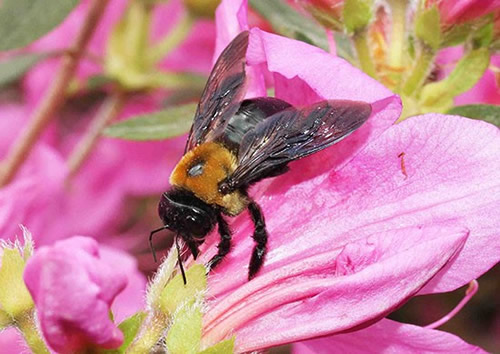Issue 7, July 13, 2020
Carpenter Bees
Carpenter bees (Xylocopa virginica) have gotten a bad rap because of their tendency to construct their nests in exterior wood structures. However, they are extremely beneficial in their pollinating services. They visit large open-faced flowers with abundant nectar and pollen like asters, coneflowers, sunflowers and blanket flower but visit many species. They use a long tongue to get nectar, but will occasionally rob nectar from small flowers like penstemon and salvia, by chewing a slit at the base near nectar. They use buzz pollination on some of our favorite garden vegetables like tomato and eggplant.

Carpenter bee on azalea blossom
Dubbed the bumble bee look-alike by Beespotter, the eastern carpenter bee can be differentiated from bumblebees by their shiny black abdomen, which lacks fuzz. Males are the most territorial but lack the stingers of females.
Eastern Carpenter Bee is a stout bee that chews holes through rotting wood with their mandibles. In nature this is dead wood in the form of limbs and trunks of dead trees. In our backyard it is unpainted fences, decks, and buildings. During April and May, females excavate wood with their sharp mandibles, leaving deposits of sawdust beneath the entrance of their nest accompanied with a yellowish smattering. She tunnels a round hole about ½ an inch in diameter and then creates complex chambers with individual cells she fills with an individual egg, nectar and pollen. She seals the chambers with a mixture of wood pulp and saliva. In late summer, the new adults emerge from the nest.
If carpenter bees have become a nuisance, deter nesting by painting or replacing wood rather than plugging holes or using insecticides. To gain their pollinating services, leave rotting tree stumps and logs in the back yard gives carpenter bees a place to build a nest.
Author:
Kelly Allsup